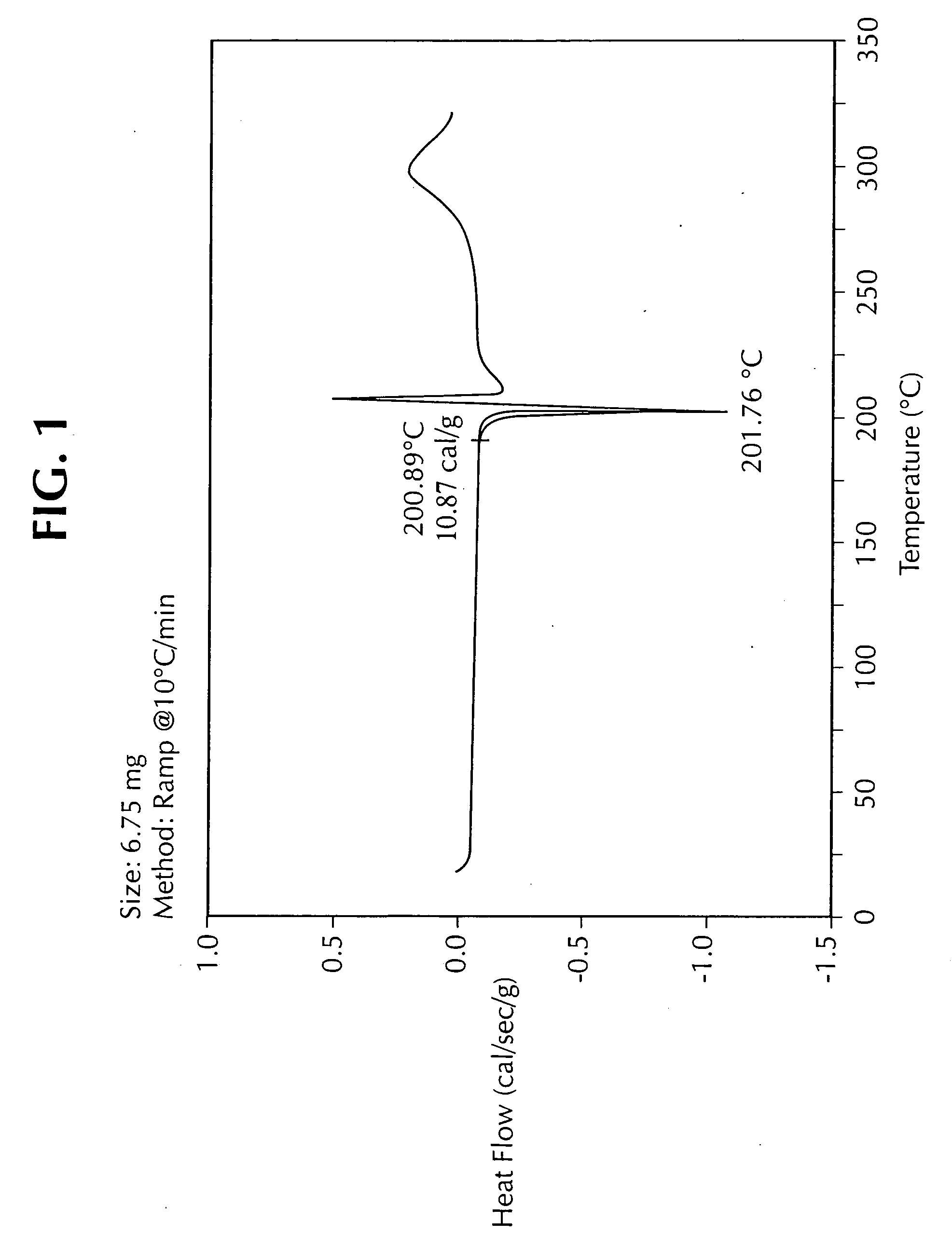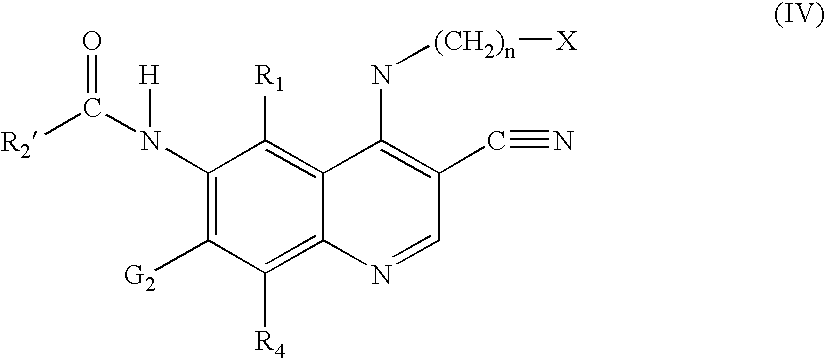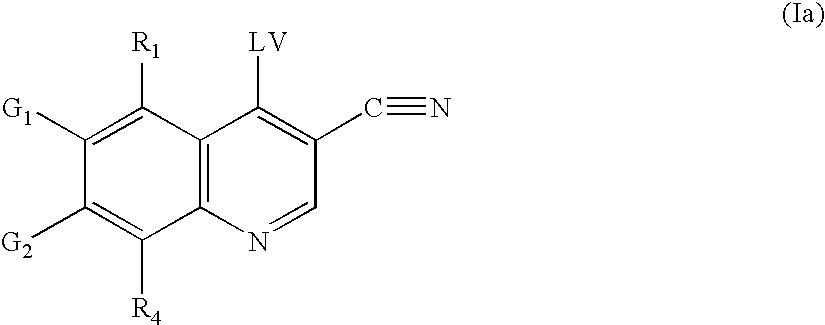Methods of synthesizing substituted 3-cyanoquinolines and intermediates thereof
a technology of cyanoquinoline and substituted 3-cyanoquinoline, which is applied in the field of methods, can solve problems such as tumor growth and cancer, and achieve the effect of facilitating large-scale manufacturing and achieving high-purity products more efficiently
- Summary
- Abstract
- Description
- Claims
- Application Information
AI Technical Summary
Benefits of technology
Problems solved by technology
Method used
Image
Examples
example 1a
[0161] To accomplish the analogous synthesis of 3-chloro-4-(3-fluorobenzyloxy)nitrobenzene, 3-fluorobenzyl alcohol (0.30 kg, 2.39 mole, 1.05 eq) was dissolved in ACN (6.0 L) and to it was added potassium hydroxide flakes (85%) (0.16 kg, 1.25 eq). The resulting suspension was warmed to 35° C. A solution of the 3-chloro-4-fluoronitrobenzene (0.40 kg, 2.28 mol) in ACN (2.0 L) was added at 35-40° C. The mixture was held for 18 hours. The mixture was then cooled back to 20-25° C., quenched with water (8 L) and the resulting slurry filtered and washed with water (2×0.40 L). The resulting product was dried at 45° C., under 10 mm Hg pressure, for 25 hours to give 0.59 kg (92% yield).
example 1b
[0162] To prepare 4-(benzyloxy)3-chloronitrobenzene, benzyl alcohol (0.34 kg, 3.14 mole, 1.10 eq) was dissolved in acetonitrile (1.70 L) and to it was added potassium hydroxide flakes (85%) (0.24 kg, 1.50 eq). The resulting suspension was warmed to 25° C. A solution of the 3-chloro-4-fluoronitrobenzene (0.50 kg, 2.85 mol, 1.0 eq) in acetonitrile (0.75 L) was added keeping the pot temperature<45° C. The mixture was held for 14 h. The mixture was then cooled back to 0-15° C., quenched with water (2.5 L) and the resulting slurry was filtered and washed with water (2×0.50 L). The resulting product was dried at 50° C., under 10 mm Hg pressure, for 24 hours to give 0.73 kg (97% yield).
[0163] Experimental results for the reaction of Example 1 with different bases and solvents are shown in Table 1. The last three entries on Table 1 are large scale runs in which a 5% excess of pyridyl carbinol was used.
TABLE 1Preparation of Nitroaryl IntermediateScaleVol-BaseTimeTempYieldPurity(g)Solventu...
example 2
[0164] Preparation of 3-chloro-4-(2-pyridylmethoxy)aniline from the nitrobenzene product of Example 1 was accomplished with catalytic hydrogenation using platinum on carbon.
[0165] A typical hydrogenation was done using 6 volumes of THF, 2% by weight of 5% Pt / C (50% water wet), at 25 psi and at 25-30° C. for approximately 4-6 hours. The reaction is slightly exothermic and the temperature will rise to about 30-35° C. Cooling is necessary to maintain the temperature below 30° C.
[0166] As a specific example, a mixture of 3-chloro-4-(2-pyridylmethoxy)nitrobenzene (0.15 kg, 0.57 mole) and 2% (w / w) of 5% Pt / C (6.0 g) in tetrahydrofuran (0.90 L) was hydrogenated at 25 psi for at least 5 hours. The mixture was filtered through a celite pad and washed with tetrahydrofuran (0.60 L). The filtrate was distilled to a volume of about 0.75 L and ethanol (1.12 L) was added. Distillation was continued to a volume of about 0.75 L and ethanol (2.85 L) was added. The mixture may be used “as is” in th...
PUM
| Property | Measurement | Unit |
|---|---|---|
| Temperature | aaaaa | aaaaa |
| Temperature | aaaaa | aaaaa |
| Temperature | aaaaa | aaaaa |
Abstract
Description
Claims
Application Information
 Login to View More
Login to View More - R&D
- Intellectual Property
- Life Sciences
- Materials
- Tech Scout
- Unparalleled Data Quality
- Higher Quality Content
- 60% Fewer Hallucinations
Browse by: Latest US Patents, China's latest patents, Technical Efficacy Thesaurus, Application Domain, Technology Topic, Popular Technical Reports.
© 2025 PatSnap. All rights reserved.Legal|Privacy policy|Modern Slavery Act Transparency Statement|Sitemap|About US| Contact US: help@patsnap.com



